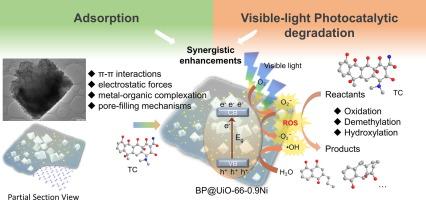Multi-Strategy optimized UiO-66 composite for simultaneous efficient adsorption and visible-light degradation of tetracycline in wastewater
IF 13.2
1区 工程技术
Q1 ENGINEERING, CHEMICAL
引用次数: 0
Abstract
Tetracycline hydrochloride (TC) is a widespread contaminant in aquatic environments, leading to the emergence of antibiotic-resistant bacteria and posing serious environmental and health threats. To address this issue, a highly efficient adsorbent-photocatalyst composite (BP@UiO-66–0.9Ni) was developed to achieve TC removal from wastewater. The results indicated that the total removal rate of TC in actual river water samples can reach 98 % after treatment with this composite, and was largely unaffected by pH and coexisting anions. Specifically, the adsorption capacity increased from 7.2 mg g−1 of the original UiO-66 to 148.3 mg g−1, which represented an enhancement of 20.6 times, while the visible-light degradation removal efficiency increased from 1.2 % to 90.2 %, representing an enhancement of 75.2 times. Moreover, under optimal pH conditions, the material exhibited a high adsorption capacity of 358 mg g−1. The enhanced adsorption was due to the combined effects of π-π interactions, electrostatic forces, metal–organic complexation, and pore-filling mechanisms. Reactive species such as ·O2− and 1O2 were generated under visible light excitation, catalyzing oxidation, demethylation, and hydroxylation in TC molecules. These processes ultimately led to the degradation and removal of TC. The improved performance of BP@UiO-66–0.9Ni also resulted from efficient charge transfer and better separation of photogenerated electron-hole pairs, which collectively contributed to its superior adsorption and photocatalytic activity. In conclusion, this study demonstrated an effective strategy for the removal of TC from wastewater, providing valuable insights for designing high-performance materials for the treatment of antibiotic-contaminated water.

多策略优化UiO-66复合材料对废水中四环素的同时高效吸附和可见光降解
盐酸四环素是水生环境中广泛存在的污染物,导致耐药菌的出现,对环境和健康构成严重威胁。为了解决这一问题,开发了一种高效的吸附剂-光催化剂复合材料(BP@UiO-66 -0.9Ni)来实现废水中TC的去除。结果表明,经该复合材料处理后,实际河流水样中TC的总去除率可达98 %,且基本不受pH和共存阴离子的影响。吸附量由原来的7.2 mg g−1提高到148.3 mg g−1,提高了20.6倍;可见光降解去除率由1.2 %提高到90.2 %,提高了75.2倍。在最佳pH条件下,该材料的吸附量为358 mg g−1。吸附增强是π-π相互作用、静电力、金属-有机络合和孔隙填充机制共同作用的结果。在可见光激发下,TC分子产生了·O2−和1O2等活性物质,催化氧化、去甲基化和羟基化。这些过程最终导致了TC的降解和去除。BP@UiO-66 -0.9Ni性能的提高还源于有效的电荷转移和光生电子-空穴对的更好分离,这共同促成了其优越的吸附和光催化活性。总之,本研究展示了从废水中去除TC的有效策略,为设计用于处理抗生素污染水的高性能材料提供了有价值的见解。
本文章由计算机程序翻译,如有差异,请以英文原文为准。
求助全文
约1分钟内获得全文
求助全文
来源期刊

Chemical Engineering Journal
工程技术-工程:化工
CiteScore
21.70
自引率
9.30%
发文量
6781
审稿时长
2.4 months
期刊介绍:
The Chemical Engineering Journal is an international research journal that invites contributions of original and novel fundamental research. It aims to provide an international platform for presenting original fundamental research, interpretative reviews, and discussions on new developments in chemical engineering. The journal welcomes papers that describe novel theory and its practical application, as well as those that demonstrate the transfer of techniques from other disciplines. It also welcomes reports on carefully conducted experimental work that is soundly interpreted. The main focus of the journal is on original and rigorous research results that have broad significance. The Catalysis section within the Chemical Engineering Journal focuses specifically on Experimental and Theoretical studies in the fields of heterogeneous catalysis, molecular catalysis, and biocatalysis. These studies have industrial impact on various sectors such as chemicals, energy, materials, foods, healthcare, and environmental protection.
 求助内容:
求助内容: 应助结果提醒方式:
应助结果提醒方式:


